In the 1940s, men's suspenders saw a transformation as button-on styles gained preference over clip-on options. These button-on suspenders featured adjustable sliders, allowing for a customized fit and a more polished look. The designs ranged widely, from elegant silk for formal occasions to bold patterns in maroon and blue, reflecting the era's style shift. World War II impacted this trend, as practicality took precedence, driving the popularity of belts. However, quality craftsmanship from brands like Albert Thurston and HICKOK sustained interest in suspenders. There's much more to explore about the styles and cultural influences shaping this iconic accessory.
Overview of 1940s Suspenders
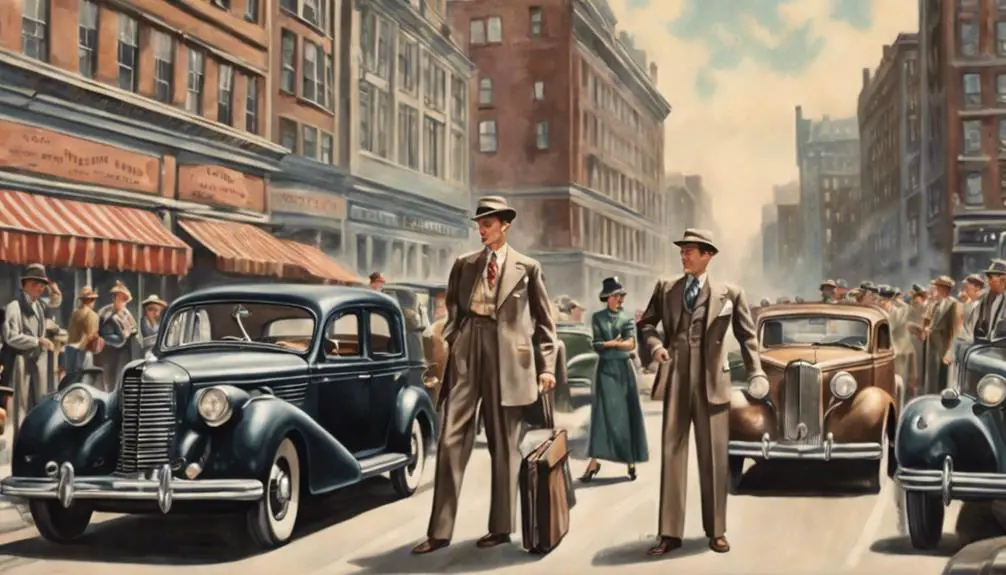
In the domain of men's fashion, the 1940s marked a significant change for suspenders, often referred to as braces. This decade saw a shift in style preferences, with a decline in sales for traditional suspenders as belts gained popularity. Button-on suspenders emerged as a popular alternative, featuring sliders for easy adjustments and exuding a vintage style that appealed to many.
The width of these men's suspenders varied, with dress options typically ranging from 3/4 to 1-1/3 inches, while sturdier work suspenders measured between 1-1/2 to 2 inches. Bold patterns and colors like maroon, brown leather, and blue dominated the fashion scene, often designed to complement matching belts and ties.
Interestingly, clip-on suspenders fell out of favor, as they were considered less stylish compared to their button-on counterparts. The influence of wartime fashion also permeated accessories, as military-style buckles became trendy. This decade, consequently, transformed suspenders into more than just functional garments; they became essential elements of a well-coordinated outfit, reflecting the evolving tastes and needs of men's fashion in that era.
Types of Suspenders in the 1940s
Suspenders in the 1940s showcased a variety of styles, primarily split between button-on and clip-on designs, though the former gained prominence during this time. Button-on suspenders featured sliders for adjustment, allowing you to customize the fit, which was especially valued in both formal and work settings. These vintage pieces often measured between 3/4 to 1-1/3 inches in width for dress occasions, while more robust work suspenders came in at 1-1/2 to 2 inches, emphasizing durability.
The design of these suspenders frequently included Y-Back configurations, enhancing both style and support. Clip-on suspenders, while available, were less favored, offering a more casual approach that didn't quite resonate with the more tailored aesthetics of the era. Bold patterns and colors—like maroon, brown, and blue—dominated the landscape, often harmonizing with matching belts and ties. Military-style buckles became a popular trend, reflecting the practical needs of servicemen during WWII. Additionally, features like herringbone patterns and adjustable lengths catered to both functionality and the fashion sensibilities of the time, making suspenders a versatile accessory in your wardrobe.
Popular Styles and Designs
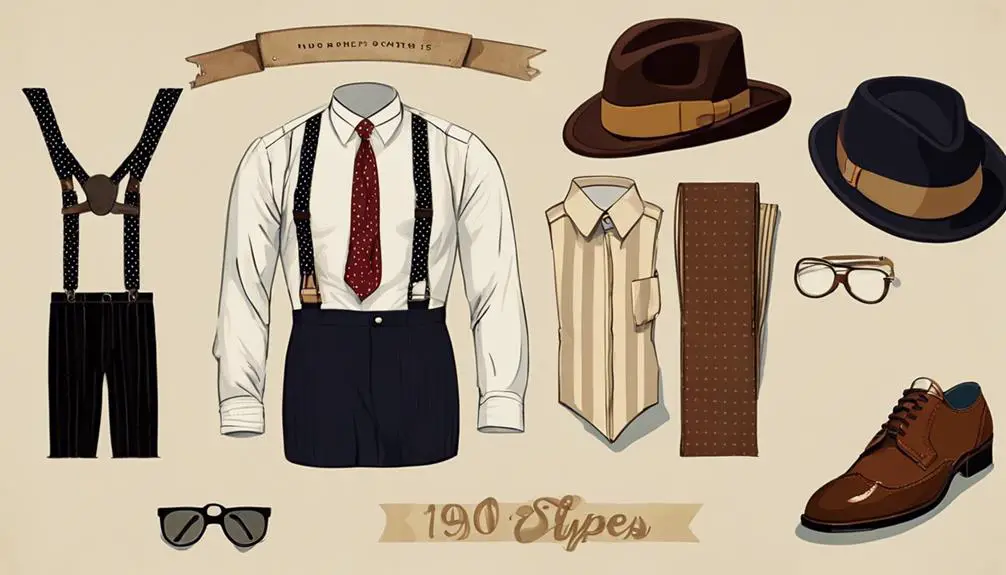
During the 1940s, men's suspenders evolved into a stylish accessory that reflected the era's fashion sensibilities and practical needs. You'd notice a shift towards button suspenders, which featured adjustable sliders, allowing for a customized fit. Clip-on options were less favored, as they didn't offer the same level of sophistication.
Suspenders of this decade showcased various styles and designs, including:
- Mens Y-Shaped: These provided both comfort and style, making them a popular choice.
- Silk Suspenders: Luxurious and smooth, silk options were often seen in formal settings.
- Wide Stripes: Bold patterns like wide stripes in maroon, brown, and blue became a fashion statement.
- Military-style buckles: Many suspenders incorporated these, often stamped with initials for a personal touch.
- Dress vs. Work Suspenders: Dress suspenders typically measured 3/4 to 1-1/3 inches wide, while work suspenders were thicker, ranging from 1-1/2 to 2 inches.
The design cleverly balanced practicality and style, aligning with the changing preferences of the time, ensuring suspenders remained not just functional, but an essential element of men's fashion.
Impact of World War II
The impact of World War II on men's fashion was profound, with many men turning away from suspenders in favor of more practical solutions like belts. The scarcity of cloth materials during the war directly influenced this change, as servicemen adopted belts for their functionality. Wartime fashion favored utilitarian styles, which led to a decline in decorative suspenders.
As trousers began to feature belt loops, the demand for suspenders diminished considerably. The 1940s also saw a surge in the production of military-style belts, often personalized with stamped initials, replacing suspenders as the go-to accessory. This alteration marked a cultural shift in men's attire, reinforced by Hollywood icons who popularized jeans with belt loops post-war.
| Factor | Effect on Suspenders |
|---|---|
| Scarcity of materials | Decreased availability of suspenders |
| Adoption of belt loops | Shifted preference away from suspenders |
| Rise of military-style belts | Substitute for suspenders |
Ultimately, the war's impact on fashion was clear: suspenders became less visible, overshadowed by the practicality and popularity of belts.
Cultural Influences on Suspenders
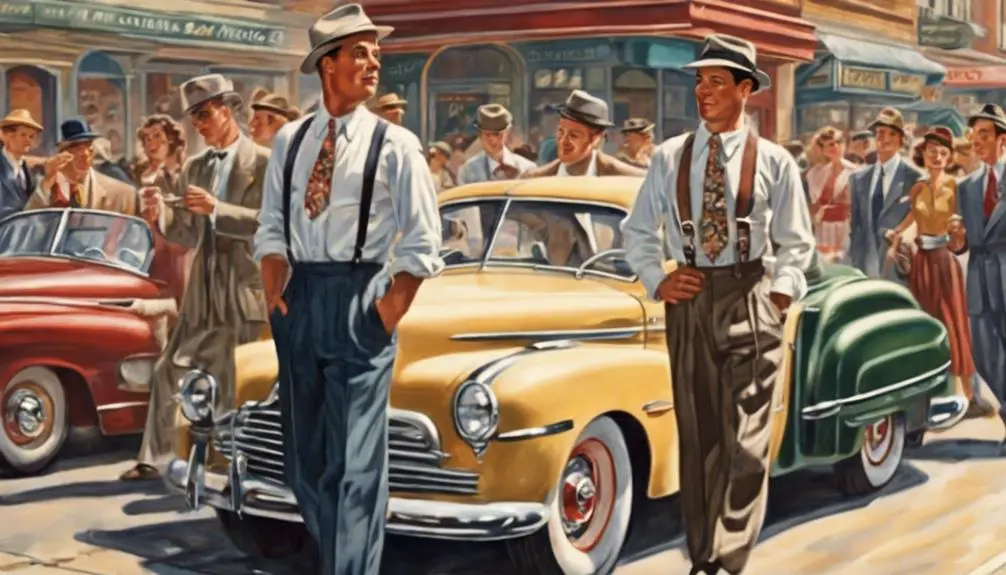
Fashion trends in the 1940s were heavily influenced by cultural shifts and societal changes, impacting the use of suspenders in men's attire. While belts gained traction as the primary method for trouser support, suspenders, or braces, still held a place in the wardrobes of the well-dressed man. The wartime fabric rationing greatly reduced the appeal of suspenders, as military-style clothing became the norm. Yet, certain styles persisted among fashion-conscious individuals who appreciated the classic charm of button suspenders.
You'll find that several cultural factors shaped these trends:
- The rise of military aesthetics during World War II emphasized functionality over flair.
- Fabric rationing led to fewer options for suspenders, pushing men toward belts.
- Youth culture introduced bold patterns and colors in accessories, rejuvenating interest.
- Hollywood icons showcased tailored styles, linking suspenders with elegance.
- Button suspenders with adjustable sliders remained popular for their sophisticated look, even in a changing landscape.
Notable Brands of the Era
As cultural influences shaped the use of suspenders in the 1940s, notable brands emerged that defined the era's style and functionality. Albert Thurston stood out for its high-quality craftsmanship and luxurious fabrics, appealing to men who valued elegance. HICKOK, another popular choice, offered adjustable suspenders that paired decorative designs with durable materials, making them suitable for both formal and casual settings.
The military's influence during WWII prompted brands to focus on practicality, with many designing suspenders that catered to servicemen's needs for both functionality and style. Dockers became synonymous with reliability, providing sturdy suspenders that were well-received in work environments and leisure activities alike.
Throughout the decade, brands emphasized bold patterns and colors such as maroon, brown, and blue, creating a vibrant palette that appealed to fashionable men. Matching sets of suspenders, belts, and ties became a popular trend, reflecting a cohesive sense of style. The Emporium Mens collection highlighted this trend, showcasing a range of options that catered to the diverse tastes of men during this transformative period.
Fashion Trends and Usage
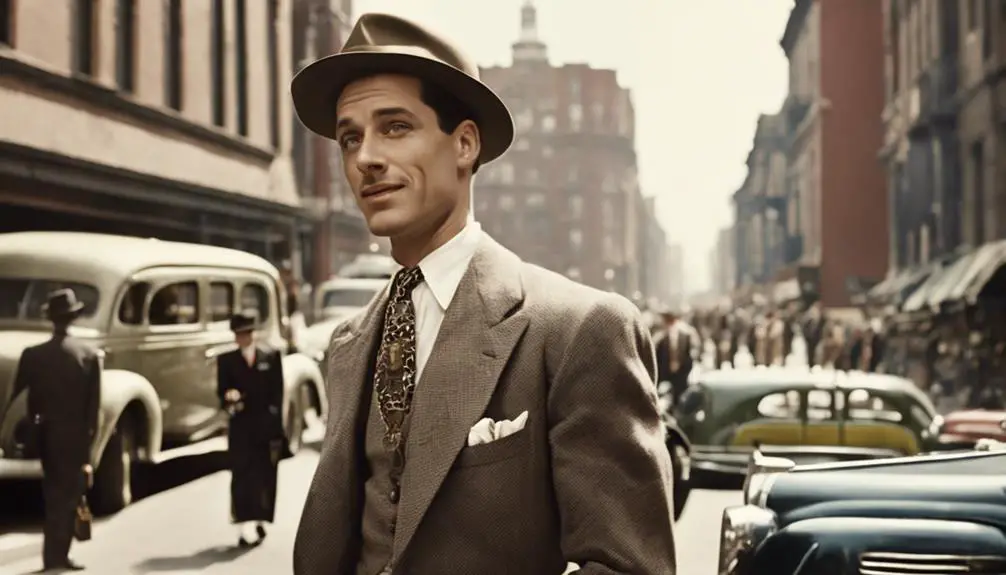
Suspenders experienced a shift in their role during the 1940s, reflecting broader changes in men's fashion preferences. While belts began to dominate as the go-to accessory for holding up trousers, button-on suspenders remained a staple for formal occasions. You'd find that dress suspenders typically measured between 3/4 to 1-1/3 inches wide, while work suspenders were thicker, reflecting their functional use.
Key fashion trends and usage during this era included:
- Silk and Solid Suspenders: Luxurious materials and solid colors were preferred for a polished look.
- Button End Made: Traditional button-on styles gained favor for their sophisticated aesthetic.
- Bold Patterns: Maroon, brown, and blue colors made a statement, often harmonizing with belts and ties.
- Clip-On Decline: Clip-on suspenders lost popularity as men sought a more refined appearance.
- Military Influence: Military-style buckles on belts showcased individuality, integrating personal flair into accessories.
As you navigate the fashion landscape of the 1940s, you'll see how suspenders, though less common, maintained their elegance in mens vintage attire.
Legacy of 1940s Suspenders
The decline of suspenders in the 1940s marked a significant change in the landscape of men's accessories, as belts increasingly took center stage. While button suspenders remained popular, particularly those featuring adjustable sliders, men began to favor belts, especially military-style buckles that complemented their outfits. This alteration didn't diminish the craftsmanship of suspenders, which were often made from high-quality materials like silk and showcased intricate designs, including the elegant Silk Y-Back style. Vintage clothing items from this era, including suspenders, often reflect unique designs and craftsmanship, representing the quality and attention to detail that defined the fashion of the time.
Suspenders offered a unique flair, with bold colors such as maroon and brown that allowed men to express their personalities while maintaining a polished appearance. However, as belts gained traction, the typical dress suspenders—measuring between 3/4 to 1-1/3 inches—started to fade from daily wear. The practicality of work suspenders, being thicker at 1 1/2 to 2 inches, couldn't compete with the streamlined appeal of belts.
Today, the legacy of 1940s suspenders endures as a symbol of classic style and craftsmanship. When you choose to wear suspenders, you're not just accessorizing; you're connecting with a bygone era that valued quality and individuality in men's fashion.
Frequently Asked Questions
What Were Men Wearing in the 1940s?
In the 1940s, you'd notice men favoring tailored suits, often paired with sleek dress shirts and ties. Casual wear included fitted trousers and stylish belts, reflecting a blend of practicality and emerging fashion trends of the era.
What Did Men Wear to Bed in the 1940s?
In the 1940s, you'd likely wear cotton or flannel pajamas, often button-up, or opt for knee-length nightshirts. Lightweight robes added sophistication, while cotton briefs or boxers provided comfort underneath, showcasing practicality in sleepwear choices.
What Accessories for Men Played an Important Part of Fashion in the 1940s?
In the 1940s, men's fashion thrived with accessories like watches, cufflinks, and pocket squares. Each piece added sophistication, reflecting personal style while complementing outfits, showcasing a blend of utility and elegance that defined the decade.
What Did Men Carry in the 1940s?
In the 1940s, you'd carry practical items like key chains and monogrammed pocket knives, while ID bracelets symbolized connections. Cufflinks adorned your shirts, and tie pins added elegance, reflecting your personal style and social status.
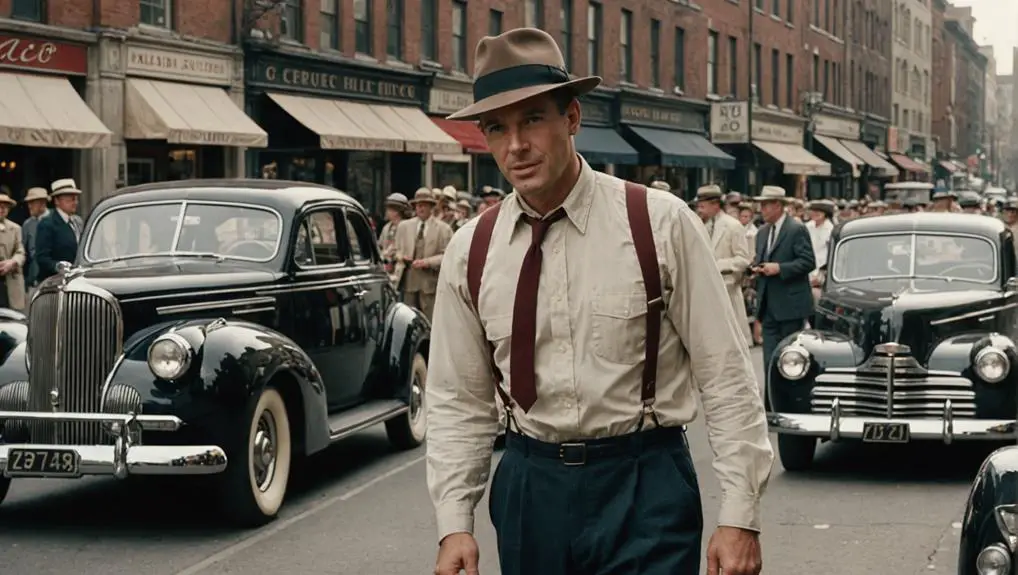



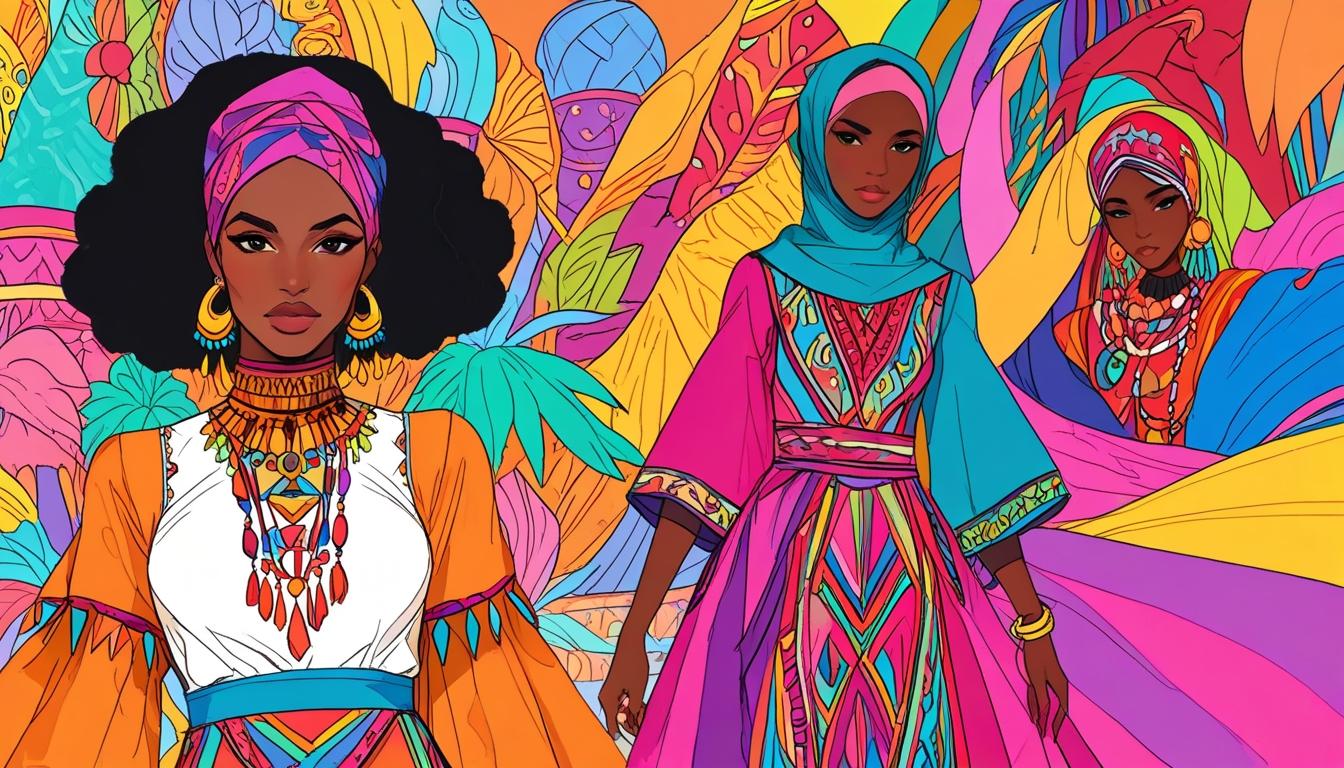
You should participate in a contest for one of the best blogs on the web. I will recommend this website!